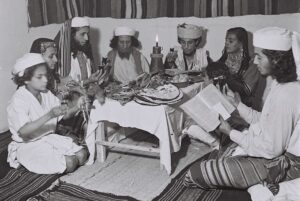This is an archive of prayers, songs, and other individual works relevant to the first course of the seder for Pesaḥ (Passover): Ḳadesh, the ritual sanctification of the festival over the first cup of wine (or grape juice). Click here to contribute a work or a transcription and translation of a historical work that you have prepared for Ḳadesh in the Seder Pesaḥ. Filter resources by Collaborator Name Filter resources by Tag Filter resources by Language Filter resources by Date Range
Rav Saadia Gaon lists three additions to the Seder Pesaḥ which he considers not necessary, but acceptable. This is the first, a poetic version of the Kiddush. Interestingly enough, it is still recited in many Yemenite communities, which are in general less likely to incorporate poetic sections to their liturgy. Here it is recorded and translated into English according to two nusḥaot — that recorded in the siddur of Rav Saadia (marked in blue), and that recorded in modern Yemenite texts (marked in red). In cases where only the spelling differs rather than the meaning, the editor generally went with Rav Saadia as the older variant. . . . Categories: Tags: Contributor(s): The following piyyut seems to have been customarily used in some Babylonian communities as an extensive replacement for the “creator of the vine-fruit” opening of the kiddush. Rav Saadia Gaon forbade it for being an alteration of the talmudic formula, but his successor Rav Hai Gaon permitted it for its cherished status. No communities today have preserved a custom of reciting it, but in 1947 Naphtali Wieder (zçl) published a text he found in the Cairo Geniza, which is replicated and translated below. Daniel Goldschmidt (zçl) suggests that it may be in it of itself a compilation of two different rites. The conjunction point is marked below with a black line. . . . Categories: Tags: Contributor(s): This is the Ḳiddush the Passover seder by Rabbi J. Leonard Levy to his Haggadah or Home Service for the Festival of Passover (1896) pp. 4-5. The prayer does not appear in subsequent editions. The prayer threads the needle between the particularly Jewish communal focus of Passover and the universalist themes that animated Levy’s Liberal Jewish mission. . . . Categories: Tags: Contributor(s): |



